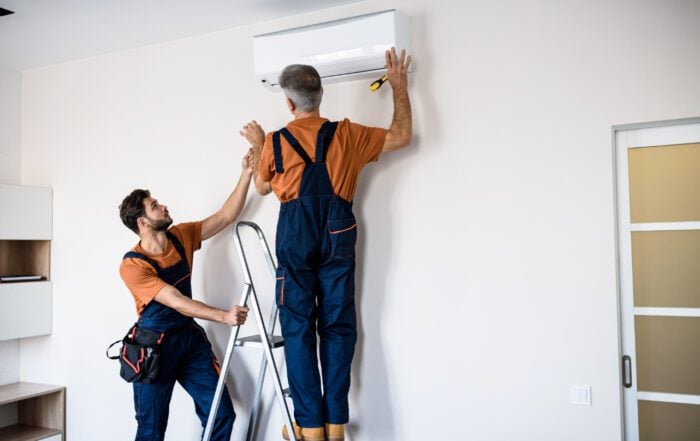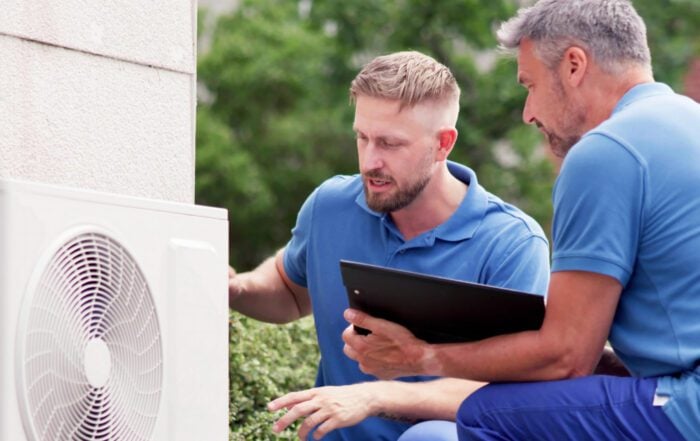All air filters are not created equal. Making sure you have the right air filter installed is an easy way to prolong the life of your furnace and increase the air quality in your Cleveland home. Checking your air filter every month and replacing it when it’s dirty benefits you in four major ways:
- Prevents dust from building up inside your system, causing expensive damage.
- Increases the efficiency of your system.
- Lowers your energy bills associated with cooling and heating your home.
- Increases your indoor air quality.
The Best Air Filters Measure Up
Filter efficiency is defined as the filter’s ability to trap and hold dust, pollen, mold, pet dander, microorganisms, and here even smoke and gases as they flow through the furnace’s air system. Not all furnace filters are the same, however. Higher-efficiency filters are more effective at helping your heating system run well and at keeping your indoor air clean.
So what do you know about air filter ratings? Unless you’re involved in the industry, ratings can be tricky to understand. And many people don’t pay attention to the ratings at all and make their decision purely on price. As an Ohio homeowner, it’s important to understand the role of air filter efficiency in your home’s air conditioning system. Take a couple of minutes to research the air filter efficiency ratings so you can find the right model for your home. The next time you go shopping to find the best filters, look for these ratings to make sure the one you buy measures up:
MERV, or minimum efficiency reporting value
The minimum efficiency reporting value (MERV) tells you the size of particles (ranging in size from 0.3 to 10 microns) the filter removes from your air. The most well-known air filter rating and the industry standard for measuring efficiency. The higher the MERV rating, the more efficient the filter is. Ratings go from 1 to 20, with one being the lowest and 17 to 20 being hospital-grade, are even more efficient and filter out much smaller particles.
Pressure drop
Also known as filter resistance, this rating indicates how much the filter affects airflow within the furnace. Furnaces require a steady and sustained source of airflow to work correctly. Filters that restrict that flow will interfere with the furnace’s operation and efficiency.
The lower the pressure drop, the higher the air filter efficiency because the air can pass through more easily. So a smaller pressure drop is desirable since it impedes airflow very little and allows the equipment to perform more efficiently. A filter’s pressure drop increases as it becomes more clogged with dust and debris. So to keep the filter functioning efficiently for as long as possible, look for ones that have low-pressure drop ratings.
Dust holding capacity
If you want to know how well the filter holds the dirt it captures at a given pressure drop, you need to identify the dust holding capacity. Look for a filter that can contain more dust at a lower pressure drop for the best furnace performance possible – more efficient filters can hold more dep. As you compare this rating between air filters, make sure the pressure drop is the same, so you get an accurate picture of how well each filter performs.
Efficiency
This rating tells you the size of the particles the filter captures – how capable the filter is at trapping dust, pollen, pet dander, bacteria, mold spores and other pollutants. As efficiency increases, the size of dust particles an air filter can catch decreases. Models with the highest air filter efficiency ratings can even capture bacteria and gases.
There are a couple of different types of efficiency when it comes to air filters.
Initial and sustained efficiencies
The initial efficiency is the rating air filters are given when they are brand new. The sustained efficiency is how well air filters perform over its entire useful life. The initial efficiency rating is not necessarily higher than the sustained efficiency rating.
Arrestance
This rating, derived from carefully controlled laboratory testing, describes how well the filter does its job of trapping and holding dust particles. Experts disagree on how useful this measurement is because it’s based on test conditions. In reality, the conditions are often much different, and the particles can be much smaller than the test particles.
Dust spot efficiency
This rating is similar to arrestance, but it focuses exclusively on dust particles. It can be useful, especially for older homes, but keep in mind that it does not include mold, bacteria or allergens.
Know Your MERV Ratings
As stated above, the Minimum Efficiency Reporting Value, or MERV, indicates the capacity of the filter for removing different-sized particles from your air. The MERV scale ranges from 1 to 20, but residential HVAC systems are designed for MERV 1-12 filters. Ratings of 17 to 20 indicate true HEPA filters, which are used in hospital settings, while ratings of 13 to 16 are highly efficient filters designed for manufacturing and similar operations.
When choosing an air filter, it’s best to avoid ratings of 1 to 4. These very inexpensive, flat models do very little to improve your air quality, trapping only large particles such as dust and pollen, but leaving behind smaller mold spores and other harmful contaminants.
Ratings of 5 to 8 indicate medium-quality filters that remove particles down to 3 microns in size, such as mold spores and particulate debris from many household chemicals.
Ratings of 9 to 12 indicate a high-quality filter, trapping particles down to one micron in size, including Legionella and humidifier dust. These filters offer excellent allergen filtration for those who suffer from respiratory conditions such as allergies and asthma.
Any filter with a rating higher than 12 may be too restrictive for your system. HEPA filters aren’t usually recommended for residential units. If you feel that you need this level of filtration, talk to a trusted HVAC professional first to make sure your system is capable of operating with these type of filters.
Air Filters Might All Look The Same, But They’re Not
When it comes time to change the filter in your HVAC system, those air filters may all look the same in the store. The truth is that there are a number of different varieties of air filters you can choose from and they all differ in price and quality. And we’re not just talking about MERV ratings.
In northeast Ohio, large and small particles can make their way indoors from a variety of sources, such as pollution, pollen, and dust. Breathing in these particles can cause a variety of health problems including allergies, asthma, and respiratory illness. Understanding what each different filter does will help you determine which type will be the best for your home.
Cotton or polyester air filters
These are the pleated versions you typically find in stores, and they are relatively affordable. Moderate-sized particles are trapped before the air is passed back into the home, and these air filters do an excellent job of maintaining pleasant indoor air quality. We recommend that you change these every two to three months for peak performance.
Carbon filters
Carbon ones work efficiently to remove odors and VOCs (volatile organic compounds) from the air we breathe. VOCs can cause a number of health problems, including asthma, fatigue, and decreased immune response. These air filters can be purchased separately to be added to a regular filter, or you can buy filters that already have carbon incorporated into them.
Fiberglass filters
You must change these more often, but they are usually the most affordable air filters on the market. Unfortunately, they are generally only effective at eliminating the largest of particles from the air. Smaller particles can still be found in the indoor air in homes that use these air filters.
HEPA filters
These are the most effective filter if you’re trying to eliminate your home from all particle sizes. HEPA filters are recommended for families that deal with allergies or respiratory disorders. Dander, pollen, mold spores and dust are all removed effectively using HEPA filters.
Think a Higher Quality Air Filter Might Work for You?
If you or a member of your household suffers from allergies or other respiratory health issues, you may be considering upgrading your air filters. When you begin to look into higher end filters, learning the basic types can help you make an informed decision.
HVAC replacement filters can be classified as one of the following types:
- The inexpensive fiberglass air filters mentioned above typically have a minimum efficiency reporting value (MERV) between 1-4; these will NOT improve indoor air quality (IAQ) for health and comfort purposes and will only remove airborne contaminants large enough to cause damage to your HVAC equipment.
- Washable air filters with MERV ratings between 1-4. These filters require extensive maintenance and tend to breed bacteria and fungi which will circulate throughout your home. Although professionals no longer recommend the use of washable filters in general, they are particularly undesirable for anyone with respiratory concerns.
- Moderately priced polyester and pleated air filters are manufactured similarly to fiberglass filters but designed to capture a much more significant percentage of particulates. With MERV ratings between 8-13, these replacement filters will significantly improve your IAQ.
- High-efficiency air filters commonly made from pleated filter paper or synthetic polyester fibers with MERV ratings between 14 and 16. When considering which air filter is best for your household, you may assume that the higher the MERV rating, the better the results. This is not, however, always the case. As the MERV rating increases, airflow moving through your HVAC unit decreases, reducing the efficiency of the system.
For most situations, the best results can be obtained with an air filter having a MERV rating between 9-12.
Sizing & Changing Your Filter
If your filter doesn’t fit properly, it won’t be advantageous. It should be snug, but you shouldn’t have to force it into place. The best place to look for this information is on your old filter unless it’s not sized correctly. In that case, measure the space inside the brackets and look for the closest measurements at the store.
Regardless of the filter you choose, replacing it on a regular basis is vital to keep it functioning properly. A standard 1-inch filter needs to be replaced every 1 to 3 months.
Your air filter is most likely in the blower compartment of your HVAC system. It slides out effortlessly, and the new one goes in with the arrows pointing in the direction of the airflow. Be sure to securely close the compartment door (if there is one) for optimum airflow.
To ensure you’re getting the best air filter efficiency for your home, contact Stack Heating & Cooling. For more than 35 years, we’ve been providing expert HVAC service and advice to northeast Ohio residents.
Our goal is to help educate our customers in Cleveland, Ohio, about energy and home comfort issues. For more information about air filter efficiency and other HVAC topics, download our free Home Comfort Resource guide.
Have Any Questions?
If this is an emergency please call 440-937-9134.
Otherwise, please feel free to call us or submit this form to schedule an appointment for service or request an estimate. We will contact you shortly!



